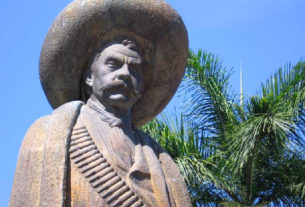“The Twenty-Two Music Professors” squared off against “The “Heavy Metal Charros,” (Heavy Metal Cowboys) separated only by the four lanes of a major cross street. Batteries of powerful lights turned an area of several square blocks of the city into day. Huge amplifiers were dotted around in a very scientific and acoustically successful manner. The City of Guadalajara was staging a municipal street dance. ” Ven a dar un chanclazo,” (come, kick the old shoes around) said the advertisements.
Because it was to be so close to our home we innocently thought it was just for our neighborhood. But when we went and saw old friends from Tlaquepaque we knew everybody had been invited. The city fathers made an equally innocent mistake; they announced the closure of three intersections but by the end of the dance eight intersections had been closed – by dancers who brought their own chillonas (boom boxes) por si las dudas (just in case) there wasn’t room for them around the bandstands. Two to three thousand people attended.
The twenty-two professors have made music together as a band for a long time. They all teach music and we’ve danced to their tunes at tardeadas (parties) at the Lion’s Club or other places which have big dance floors and well-heeled clienteles. They’re very popular at the annual balls of such groups as the Círculo Autlense (businessmen born in nearby Autlan) or Circulo Colimense (businessmen born in Colima, another nearby city), and for the club’s own annual black tie affair.
They know every tune Sinatra knew and mix them in with lots of Latin gems of the same vintage. But I don’t like their habit of playing famous favorites such as, ” La del moño colorado,” (“the girl with the red bow”) to a tango rhythm when it’s really a cumbia. Even so, their tunes are easier to dance to than those of the Heavy Metal Charros.
The city chose a great street for the dance. It has three lanes going north, three lanes south, and a camellón (divider) of the same width in the middle. In other words, it’s a big important street. People danced on the streets, sidewalks and on the camellón. The bands were seated in the camellon, facing each other across Hidalgo and taking turns playing.
“The Heavy Metal Charros” also had about twenty-two musicians. They played everything at the speed Perlman played “The Flight of the Bumblebee” and were just as impossible to dance to. The dance couples they attracted weren’t businessmen from Colima, you can bet; these dancers would throw their ladies straight up in the air and give them a hard spin at the same time. I was lost in admiration and started to speak to Delia. She beat me to it, ” Ni pensar,” she whispered menacingly, (don’t even think of it.) Were some of those couples from Cuba? We have kibitzed enough dances to think Cubans are the best dancers.
Kibitzing at a dance is half the fun of going. It seems like with every given tune, one couple stands out as the best on the floor and you and your neighbors will discuss their merits. ” Voy polla,” (I think the girl is the better), somebody will say, or ” voy pollo” (I think the guy is the better). You have to be careful listening to the vowel endings or you’ll confuse the sexes – but isn’t that true of the whole Spanish language?
However, if you’re in Guadalajara and somebody says, ” Voy Chivas,” it doesn’t mean they like she-goats, it means they like a soccer team by that name, a team that is a great sentimental favorite throughout Mexico because they hire only Mexican players – a team that once had a problem so complex they almost went to the Supreme Court or the Pope for a solution, “If a great prospective player is born of Mexican parents in Los Angeles, in his heart and soul isn’t he really still a Mexican?” The Pope was bypassed; public opinion decided the young man was a Mexican and he was duly hired.
Dancing, after soccer, is the second national sport of Mexico. I can truthfully say that I have never been to a party thrown by a Mexican citizen that hasn’t featured dancing. At Doctor Francisco’s house we even dance on a tiny 8 by 12 patio. One big reason for throwing dances is the cheapness of live music, the music that dancers prefer.
And I know of two musical groups who will play free if you let them bring their wives along and eat all they want. Their music is pretty good and one group is composed of professional men who just like to make music. From this custom originates the expression, ” panza de músico,” meaning two things simultaneously: 1) musicians have cast iron stomachs; 2) musicians have bottomless stomachs.
The city’s street dance was a great success because all the people who attended were lovers of the dance – there were no drunks that I could see. Four American girls I had never seen before had arrived late and were therefore off in the periphery where the chillona dancers made them welcome. The last I saw of them, they were being thrown up in the air.


